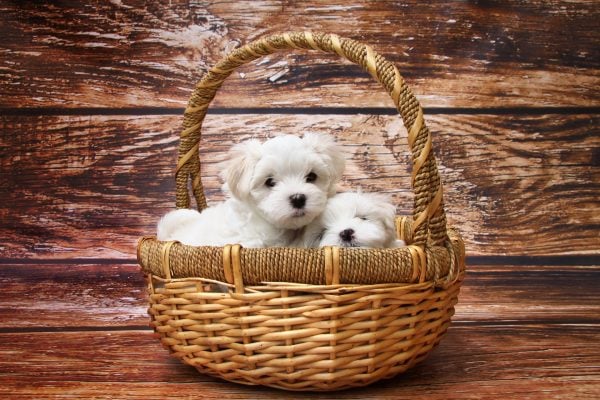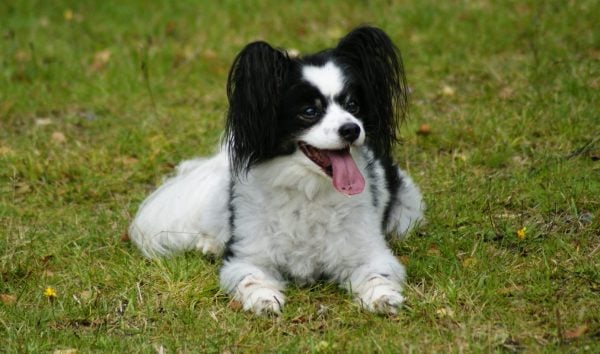- Not a substitute for professional veterinary help.
From tiny Chihuahuas who can nap in your palm to heftier Pugs who can still fit in a bag, small dogs have a way of capturing hearts in a major way.
There are plenty of small dogs in the world, but the current titleholder for the shortest dog in the world is Pearl, a Chihuahua from Florida. She’s just 3.59 inches tall and weighs only 1.22 pounds!
In terms of official classification, very small dogs fall into the Toy Group breed category. These dogs are bred primarily for companionship and typically weigh less than 20 pounds when fully grown. Breeders may use terms like “teacup” and “miniature” in marketing, but the AKC doesn’t recognize these labels.
Below, find a list of the 10 smallest dog breeds in the world—so you can find your perfect pint-sized pup!
Chihuahua
- Adult weight: 2-6 pounds (lbs)
- Adult height: 5-8 inches
Chihuahuas are known for having plenty of personality packed into their tiny frame. Despite their size, they often believe they’re much bigger, so early training and socialization are a must.
They have large, expressive eyes and apple-shaped heads. They’re lively, loyal, and love to burrow under blankets. Watch out for dental and anal sac issues, and be sure to keep them warm in cold weather.
Maltese
- Adult weight: 4-7 lbs
- Adult height: 7-9 inches
Maltese dogs have grown in popularity worldwide because they’re so loving, portable, and adapt well to changes as long as they are with their pet parents, says Theresa Meyer, Maltese Club of Greater Miami secretary and co-owner of TNT Maltese.
If you’re considering a Maltese, Meyer recommends checking the American Maltese Association website and attending local dog shows to learn more about the breed to find out if they’d make a good fit for you.
The price of a Maltese varies, but a well-bred Maltese puppy can cost anywhere from $2800-$4000,” Meyer says.
Yorkshire Terrier
- Adult weight: Under 7 lbs
- Adult height: 7-8 inches
Yorkies are spirited, confident dogs who have lots of energy to burn. They need a regular exercise routine, unlike some smaller lapdogs.
Their long, glossy coats need consistent grooming, and many pet parents opt for the easier-to-maintain puppy cut.
Biewer Terrier
- Adult weight: 4-8 lbs
- Adult height: 7-11 inches
“Biewer Terriers are fun-loving and adore being with their humans at all times,” explains JoAnn Rausch, co-founder of JoDi’s Maltese and Biewer Terriers. “They are nosy and curious.”
If you’re a travel enthusiast, the Biewer Terrier might make a good match for you! These dogs do very well traveling by both car and plane, according to Rausch.
A puppy from a reputable breeder can cost anywhere from $3500-$4000 for a girl and $3000-$3500 for a boy, Rausch says.
Papillon
- Adult weight: 5-10 lbs
- Adult height: 8-11 inches
“Papillons are fun, versatile little dogs who love to hike, fetch, and explore the world with their people,” says Miranda Booth, Papillon Club of America member and co-owner of Tylane Papillons. “Training comes easily to them because they’re super intelligent and eager to please.”
When it comes to grooming a Papillon’s long, silky coat, Booth recommends using a quality shampoo and conditioner followed by thorough brushing with a pin brush or comb. “Pay special attention to armpits, culottes, and base of the ears, where mats can form,” she says.
Toy Poodle
- Adult weight: 6-10 lbs
- Adult height: Up to 10 inches
Toy Poodles combine intelligence with elegance in a petite package. Their low-shedding curly coats paired with their trainability have made them a popular choice among pet parents.
These dogs are athletic, so they do need daily walks and exercise to stay happy and healthy. If you need help meeting your pup’s exercise needs, a local Rover dog walker can help them get out some of their extra energy.
Miniature Pinscher
- Adult weight: 8-10 lbs
- Adult height: 10-12.5 inches
Miniature Pinschers are often mistakenly considered miniature Doberman Pinschers, but they’re a separate breed. These sleek dogs are full of attitude. They have short coats that don’t need too much maintenance.
Min Pins are very energetic and need regular exercise. They’re also prone to making escapes, so you’ll want to have a secure yard and a dog GPS before bringing one home!
Pekingese
- Adult weight: 7-14 lbs
- Adult height: 6-9 inches
Pekingese have captured hearts for decades.
This breed was much more popular in the 1960s and 1970s, according to Susan Shephard, PCA Gold and AKC Breeder of Merit at Deja vu Pekingese, but they still have a very loyal following today.
These dogs have distinctive coats with long, coarse hair on the outside and thick, soft fur underneath.
Shepherd says many people prefer to keep their companion Peke in a puppy cut, which a groomer can do every 8-12 weeks.
Shih Tzu
- Adult weight: 9-16 lbs
- Adult height: 9-10.5 inches
Shih Tzus were bred to look like lions, but these dogs are anything but fierce. These friendly, outgoing pups are known for their luxurious coats and love of attention. They need regular grooming and lots of attention, but they’re pretty adaptable. They can be prone to breathing issues in the heat due to their short muzzles.
A Shih Tzu’s cost can vary, based on factors like location and dog lineage, but you can expect to pay anywhere from $500-$5000, sometimes more, to bring one home.
Pug
- Adult weight: 14-18 lbs
- Adult height: 10-13 inches
“The typical temperament of a Pug is sweet, low-key, and happy,” says Chris Tucker, co-owner of Indigo Pugs.
If you like lazy Sunday mornings in bed, then a Pug might be for you!
The ideal living environment for a Pug would be indoors on a couch or your lap, says Karen Grueninger, breeder and member of the Pug Dog Club of America. She adds that, as a flat-nosed breed, Pugs don’t do well outdoors in the heat or extreme cold.
“A Pug can cost $3000-$4000,” Tucker says, adding that they come in only two colors: fawn and black. A Pug in any other color would be a mixed breed.
Smallest Dog FAQs
What are small dogs good for?
Small dogs make wonderful companions, especially for people who live in apartments or have limited space. They’re easier to travel with and often content with indoor play and shorter walks. Many small breeds are affectionate lapdogs who bond closely with their people. This makes them ideal emotional support animals and snuggle buddies.
What are teacup dogs?
“‘Teacup’ is a phrase coined by puppy mills and other unethical breeders,” Shephard explains, adding that “teacup” sized dogs are often runt puppies who may have short, unhealthy lives. This is because breeding dogs for extreme smallness comes with many health risks, like fragile bones and organ problems.
If a breeder uses the word “teacup” as a selling point, this can be a red flag. Shephard emphasizes the importance of buying from a preservation breeder. You can find these ethical breeders on the dog breed’s club website.
Do miniature and tiny dogs have more issues than larger dogs?
Smaller dogs can be more prone to certain health issues, like tracheal collapse, dental disease, and luxating patella. That said, they may have a lower risk of other issues, like hip dysplasia.
Buying a puppy from a breeder who does health testing on the parent dogs can help make sure you get a healthy puppy. “Any dogs used in a breeding program should have certificates verifying their hearts, patellas, and eyes have been checked,” Booth explains.
Are smaller dogs cheaper?
“Smaller breeds are not necessarily cheaper than larger dogs,” Grueninger says.
Some smaller dogs may have a lower upfront cost, but this depends on more than size. For instance, breeds that are easier to find may cost less than rarer breeds.
If you buy your dog from a puppy mill or backyard breeder, you may end up paying more in vet bills due to inbreeding and other health concerns. However, small dogs will cost less to feed than larger dogs! Learn more in our Cost of Dog Parenthood hub.
Is small dog syndrome common in small dogs?
“Small dog syndrome” refers to behaviors like excessive barking, guarding, or bossiness. These tendencies often show up when small dogs don’t get consistent training and boundaries. Their smaller size can make them seem less threatening than larger breeds, so their behavior is more likely to be overlooked. But small dogs still need structure, socialization, and clear guidance, just like big dogs do!







